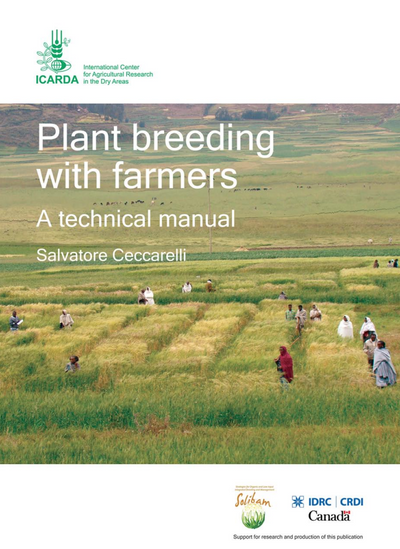Plant breeding with farmers - A technical manual
S. Ceccarelli

Salvatore Ceccarelli. (2/5/2012). Plant Breeding with Farmers: A technical manual. Beirut, Lebanon: International Center for Agricultural Research in the Dry Areas (ICARDA).
This manual on Participatory Plant Breeding (PPB) is based primarily on the direct experience derived from several years of implementing PPB programmes in a number of countries and on a number of crops, and secondly, from a number of training courses (China, Ethiopia, Jordan, Australia, South Africa) and when necessary, on relevant scientific literature, as part of the ICARDA research programme. The methods presented here have been used by in rural communities over the course of several years particularly in North Africa (Tunisia, Morocco, Egypt and Algeria), the Horn of Africa (Eritrea and Ethiopia), the Arabian Peninsula (Yemen), the Near East (Syria, Jordan and Iran) and by others (NGOs, Universities, IARCs, etc.) in other countries. Most probably the methods described will not suit every situation that researchers and partners are likely to encounter; therefore, the manual will attempt to give some general principles that may help in adjusting the methodologies to new situations. PPB is defined here as that type of plant breeding in which farmers, as well as other partners, such as extension staff, seed producers, traders and NGOs, participate in the development of a new variety. The definition implies that a breeding programme cannot be defined “participatory” unless it is inclusive (particularly with reference to gender) and therefore gender is not treated as a separate issue. The manual describes how to organize a PPB programme in self-pollinated, crosspollinated and vegetatively propagated crops, how to design the trials, collect, organize and analyse the data, and eventually how to use and share the information generated by a PPB programme. The overall objective is to show that Institutions responsible for plant breeding can organize their plant breeding programmes in a participatory manner and therefore in many cases the topics discussed are common to PPB and to Conventional Plant Breeding (CPB); this underlines that a PPB programme can be organized on scientific grounds as solid as those on which a CPB programme is based. The manual begins with definitions, as there is still much confusion about what PPB is, followed by six sections on organizational issues, data collection, experimental designs, data entry, data analysis, and variety release and seed production. It is important for readers to understand that this manual does not pretend to convert scientists to PPB or to offer the final word on PPB. Also, it is not a fully comprehensive exposition of all methods available for PPB.
Publication Details
- Published: 2012
- Publisher: ICARDA
- ISBN-10: 92-9127-271-X
- Dewey Decimal: 631.52
- ECHO Library: 631.52 CEC